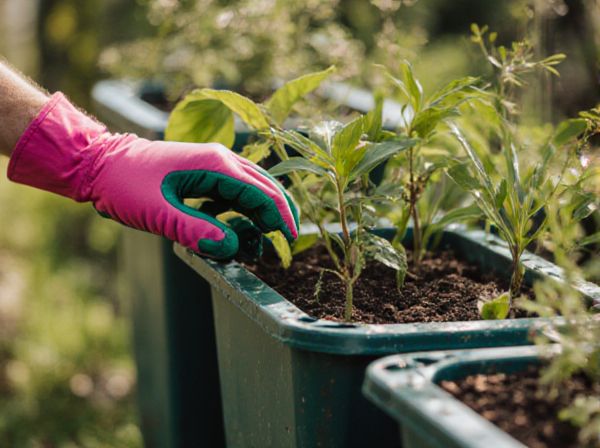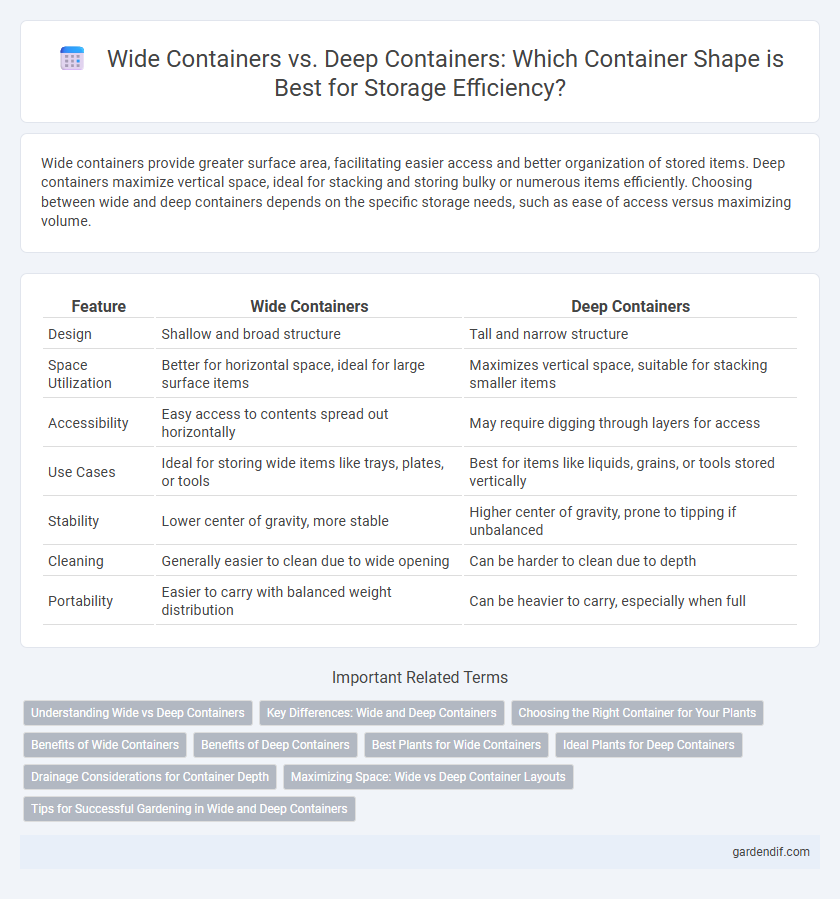
Wide containers vs deep containers Illustration
Wide containers provide greater surface area, facilitating easier access and better organization of stored items. Deep containers maximize vertical space, ideal for stacking and storing bulky or numerous items efficiently. Choosing between wide and deep containers depends on the specific storage needs, such as ease of access versus maximizing volume.
Table of Comparison
| Feature | Wide Containers | Deep Containers |
|---|---|---|
| Design | Shallow and broad structure | Tall and narrow structure |
| Space Utilization | Better for horizontal space, ideal for large surface items | Maximizes vertical space, suitable for stacking smaller items |
| Accessibility | Easy access to contents spread out horizontally | May require digging through layers for access |
| Use Cases | Ideal for storing wide items like trays, plates, or tools | Best for items like liquids, grains, or tools stored vertically |
| Stability | Lower center of gravity, more stable | Higher center of gravity, prone to tipping if unbalanced |
| Cleaning | Generally easier to clean due to wide opening | Can be harder to clean due to depth |
| Portability | Easier to carry with balanced weight distribution | Can be heavier to carry, especially when full |
Understanding Wide vs Deep Containers
Wide containers feature broad, shallow designs ideal for housing low-growing plants, providing better air circulation and easier access to each plant, enhancing growth and maintenance. Deep containers allow for extensive root development, making them suitable for taller plants and root vegetables that require more soil depth for nutrient absorption and stability. Choosing between wide vs deep containers depends on plant type, root structure, and growth requirements to optimize container gardening success.
Key Differences: Wide and Deep Containers
Wide containers offer larger surface areas, making them ideal for shallow-rooted plants that require ample space for spreading but less soil depth. Deep containers provide significant soil volume, supporting deep-rooted plants by promoting stronger root development and better moisture retention. Choosing between wide and deep containers depends on the specific plant species' root architecture and growth requirements.
Choosing the Right Container for Your Plants
Choosing between wide and deep containers depends on the plant's root structure and growth habits; wide containers are ideal for spreading roots like succulents and shallow-rooted herbs, while deep containers suit plants with long taproots such as tomatoes or carrots. Soil aeration and drainage improve in wide containers, promoting healthier root development and preventing waterlogging. Selecting the appropriate container size enhances plant growth, reduces transplant shock, and optimizes space for nutrient absorption.
Benefits of Wide Containers
Wide containers maximize horizontal storage space, enabling easier access and organization of large or irregularly shaped items. They enhance efficiency in environments where quick retrieval and visibility of contents are critical, such as warehouses and shipping operations. By reducing stacking height, wide containers also improve safety and stability during transport and handling.
Benefits of Deep Containers
Deep containers offer increased storage capacity in a compact footprint, maximizing space efficiency for bulkier items. Their design reduces the need for frequent refilling and minimizes clutter by accommodating larger volumes within the same storage area. This makes deep containers ideal for industrial use, warehouse organization, and shipping applications requiring optimal space utilization.
Best Plants for Wide Containers
Wide containers provide ample surface area and better airflow, making them ideal for plants like lettuce, herbs, and succulents that require spreading roots and space for growth. These containers promote healthier root development and reduce overcrowding compared to deep containers, benefiting shallow-rooted plants such as strawberries and pansies. Selecting wide containers enhances drainage and sunlight exposure, optimizing growth for plants preferring horizontal expansion.
Ideal Plants for Deep Containers
Deep containers are ideal for plants with extensive root systems such as tomatoes, carrots, and hydrangeas, allowing roots to grow freely and access adequate nutrients. These containers retain moisture longer, which benefits plants requiring consistent hydration and deeper soil layers. Selecting deep containers enhances growth for root vegetables and tall plants by providing stability and improved aeration.
Drainage Considerations for Container Depth
Wide containers typically allow for better surface drainage, reducing water retention at the roots, whereas deep containers require effective bottom drainage to prevent waterlogging. Ensuring sufficient drainage holes and using well-draining soil in deep containers is critical to avoid root rot and promote healthy aeration. Proper drainage design in container depth optimizes moisture levels and supports robust plant growth.
Maximizing Space: Wide vs Deep Container Layouts
Wide containers optimize horizontal space by allowing easier access and visibility of stored items, ideal for quick retrieval environments. Deep containers maximize vertical storage capacity, suitable for stacking and storing bulkier items but may require additional handling tools. Balancing wide and deep container layouts enhances overall warehouse efficiency by improving space utilization and workflow.
Tips for Successful Gardening in Wide and Deep Containers
Wide containers provide ample surface area, promoting healthy root expansion and better airflow, which helps prevent root rot and ensures vigorous plant growth. Deep containers enhance water retention and allow roots to grow downward, ideal for plants with long taproots like tomatoes and carrots. To maximize gardening success, choose wide containers for shallow-rooted plants and deep containers for those requiring deeper soil, while ensuring proper drainage and consistent watering tailored to each type.
Wide containers vs deep containers Infographic

 gardendif.com
gardendif.com